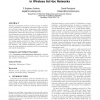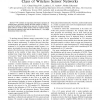949 search results - page 88 / 190 » Dependable Geographical Routing on Wireless Sensor Networks |
119
click to vote
WINET
2011
14 years 6 months ago
2011
Sleep scheduling, which is putting some sensor nodes into sleep mode without harming network functionality, is a common method to reduce energy consumption in dense wireless sensor...
112
click to vote
IPSN
2004
Springer
15 years 4 months ago
2004
Springer
Topology management schemes conserve energy in wireless ad hoc networks by identifying redundant nodes that may turn off their radios or other components while maintaining connec...
GLOBECOM
2006
IEEE
15 years 5 months ago
2006
IEEE
— Reducing energy consumption has been a recent focus of wireless sensor network research. Topology control explores the potential that a dense network has for energy savings. On...
IJSNET
2008
14 years 11 months ago
2008
: Interference from colocated networks operating over the same frequency range, becomes an increasingly severe problem as the number of networks overlapping geographically increase...
ICC
2008
IEEE
15 years 5 months ago
2008
IEEE
— We consider an important performance measure of wireless sensor networks, namely, the least number of nodes, N, required to facilitate routing between any pair of nodes, allowi...



